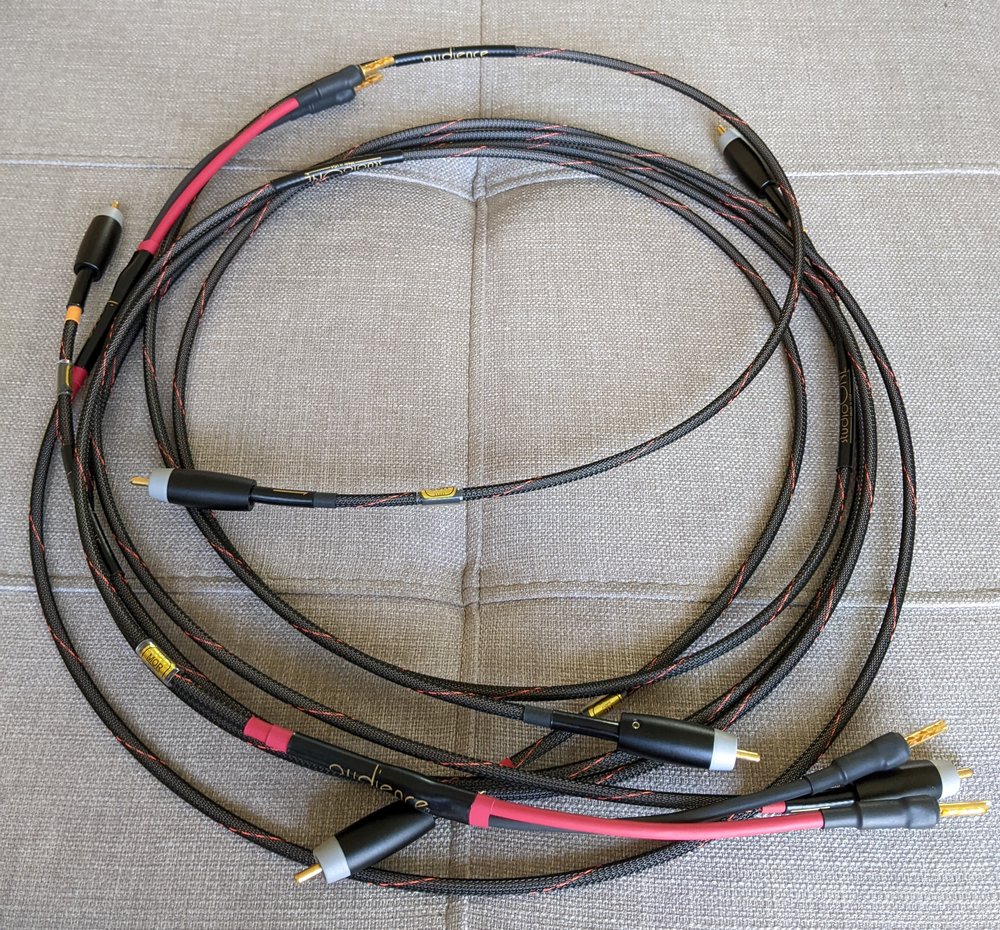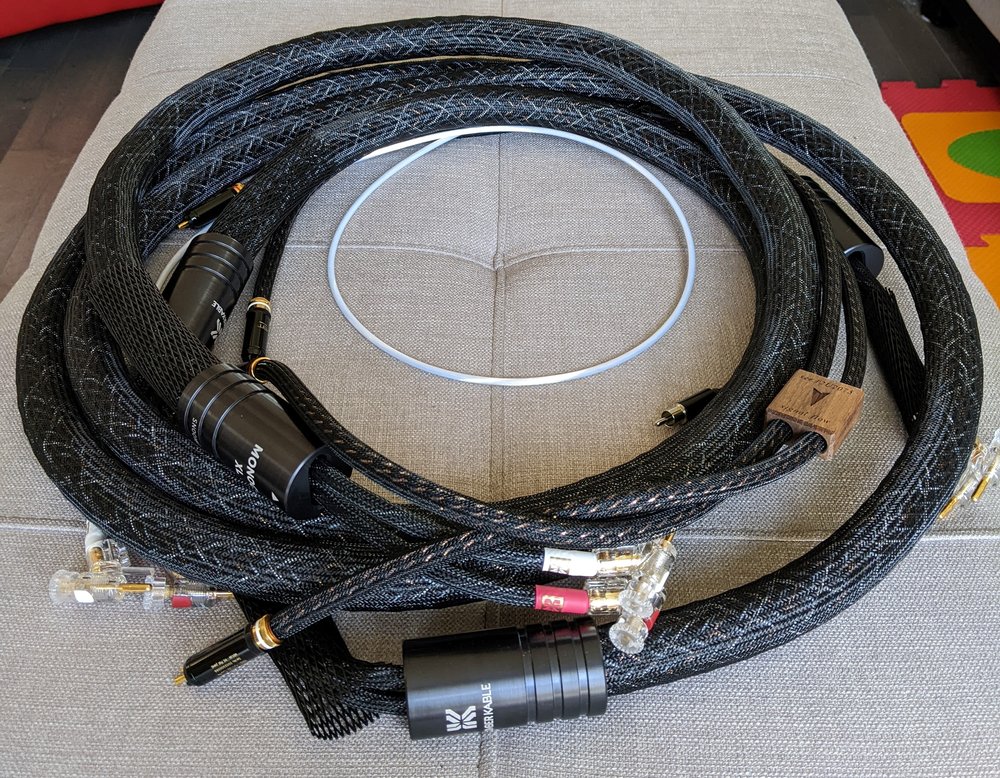
Many audiophiles endorse the concept of cable looms, i.e. using the same brand of cables in their system, from the same series if possible. Alleged benefits include a sonic coherence—a synergy—that’s derived from using cables built the same way, according to the same design principles, and thereby share one “continuous” sound. These cables were, after all, designed to play well together. The idea makes sense, but is this “loom is best” theory necessarily true? Everything is colored to some degree. If using cables from the same series causes an accumulation of unwanted colorations, wouldn’t it defeat the purpose?
Since before this series began, I was curious to try these cables in looms, which is why I asked for speaker cables, interconnects, and digital cables that either came from the same series, or were as closely matched as possible. Some series simply don’t include another type of cable, such as a speaker line of cables that doesn’t include digital cables. I then, after having done my previous sonic assessments of these cables in this ongoing series, got curious about something else. I’ll get to that soon.
“But what about power cords?” some of you may be wondering. “Shouldn’t they be part of a loom?” I didn’t include them because a power cable is a very different breed of cable from the ones here, in that they don’t transfer music. There’s no music signal being passed off in a power cable as it is from, say, a signal cable that transfers electrical voltage or a series of binary numbers from one component to the next. Power cords deliver current, period. But I do have plans to report on power cables in a future installment, at such a time as the Guru is feeling garrulous.
Surprises I encountered? Three big ones, one from each loom, which I’ll get into.

Audience
Audience Studio ONE digital cable ($749, 1.5m) / Audience Studio ONE Interconnect ($999, 1m) / Audience Studio ONE speaker cable ($2300, 2.5m)
Considering these cables are all Studio ONEs, and each brought a familiar sound to the proceedings regardless of the cable configuration it was in, I did have an idea of what to expect, and it’s what I got: warm, sweet, rich sound. On the first track on the CD A Light For Attracting Attention from the band The Smile, Thom Yorke’s latest side project, the upper midrange produced a seductive, vibrant, heartbeat-like undercurrent. And although most of the music on this release is electronic in nature, it moved organically, gracefully, almost as if on a cushion of air.
This loom did in-room soundstage extension like nobody’s business, imprinting the air between me and the system with layers of reverberant holographic images and thick harmonic trails. But that’s not the surprise I was referring to. The surprise was the size! With the Studio ONEs teamed up, the images from both Nils Petter Molvær’s Khmer and Medeski Martin & Wood’s Last Chance to Dance Trance (Perhaps) CDs had grown taller than I could’ve predicted from my previous experiences with the Audience cables. Instruments had gained scale, along with body and flesh. Listening to the double-bass on the MMW album and then on Patricia Barber’s Live performance CD Companion, I thought: “Duke Ellington would have loved these cables.” Because not only did the bass lines sound physical, tangible, and rhythmic, they had that swing. Patricia Barber’s voice was a mix of sweet and throaty, while notes from her keyboard were smooth and colorfully resonant.
Highlights: in-room extension, organic flow, tall images, rhythmic momentum
Takeaway: Seductively fun to listen to.

AudioQuest
AudioQuest Carbon digital cable ($289.95, 1.5m) / AudioQuest Yukon interconnect ($450, 1m) / AudioQuest Robin Hood ZERO speaker cable ($1790, 8ft)
Since none of the AudioQuest cables here belong to the same series, I wasn’t sure what to expect, but I didn’t expect the magnitude of what transpired. As much as I liked the individual sonic contributions of each of these cables mixed in with the other brands, hearing their effect together was the epitome of the definition of “the whole being greater than the sum of its parts”. This is no diss on these cables’ individual qualities—they’re great-sounding on their own—just an observation of their exceptional synergy together, which is the point of the loom argument. First, the bass. On MMW’s Last Chance to Dance Trance (Perhaps), it was a force of nature, simultaneously tight and fat, just the way it should be. The soundstage on Patricia Barber’s Companion was deep, detailed, and populated by real people—real musicians with their instruments, sure, but real glass-clinking patrons, too, who moved, and whose handclaps emitted their own echo-auras that lit up the venue. Barber’s keyboard notes were explicit, colorful, and clear to an almost magnified degree. Her voice: breathy, delicate and accompanied by a sense of facial recognition.
On Nils Petter Molvær’s Khmer, I heard exquisitely detailed and delicate brushwork, a motherload of hall ambience, instruments with lifelike presence, and a presentation that had a near ideal tonal balance. It was loomtastic!
Highlights: detail, transparency, realism, bass, tonal balance
Takeaway: These cables perform even better together than they do separately.

Kimber Kable
Kimber Kable Illuminations D60 ($620, 1.5m) / Kimber Kable Select KS 1016 interconnect ($960, 1m) / Kimber Kable Monocle XL speaker cable ($2460, 2.5m)
I’ll get straight to the surprise: the bass. Not that there was more of it than I expected from listening to the Kimbers in the other setups. It just seemed to have gelled into a more perfectly tight, multifaceted thing. And that was just the start of the fun. Barber’s voice was smooth, refined, breathy, and oh so human. The Kimber trio excelled in producing realistic timbres and revealing layers of detail, none at the expense of listening fatigue. The tambourine cymbal shakes, the finger snaps, the sense of hearing human skin sticking to the bongo’s skin, the softest taps on the bass drum—it was an embarrassment of detail-within-detail riches. Cowbell? It’s there! You want transparency? I had the impression of hearing a musical note or line go through an entire lifespan, from its moment of creation through its teenage and adult life stages to its eventual decay and death from old age. Everything was micro-dynamically charged. Instruments, the performance, the playing techniques, the timbres, the spaces between spaces—it all sounded sophisticated, explicitly well-sorted, and, more importantly, real-life authentic.
This felt, again, like validation of the loom concept, where the whole is greater than the sum of its parts, as good as those parts may be on their own. It was loomerific!
Highlights: detail, more detail, transparency, realism, bass, sophistication
Takeaway: Do I even want more?
*
At this point in this series, as I type these words, I feel tempted to call it a day and chalk up this whole Guru experiment so far to a win for the loom team, and encourage anyone looking to get the best cable setup to just speak to a reputable manufacturer or reseller and let them lend you their sweet-spot cable loom for you to try at home.
But I’m not willing to say that yet. Remember when I said: “after I did my previous sonic assessments of the cables involved in this ongoing series, I got curious about something else. I’ll get to that soon.” Well, soon is now. Maybe it’s crazy—I admit this idea came to me before I did the looms, and now that I did them I’ve been questioning the rationality of pursuing this next step. But I’ll do it anyway, because a) I’m not the wisest guru around and, b) I can’t help wonder if I could in some way mix and match these AudioQuest, Kimber Kable, and Audience cables to come up with something that’ll sound even better than the looms described above. It’s a tall order, and it might not work, but if it does, I promise you the result will be something else.
Stay tuned.










Leave a Reply